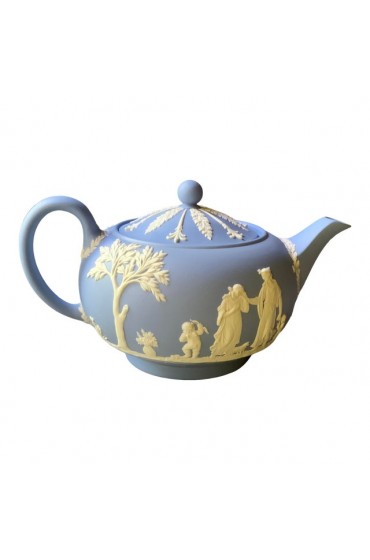Availability: In Stock
For your consideration...
A teapot worthy of The Queen, or The Queen of the House!
A beautiful and very fine classical Wedgwood blue jasper ware teapot in the “Augurs Style” *Vibrant Light Blue Set upon with a tableau of classical ladies in Grecian costume...Wonderful leaf and spear or torch decoration on rim.
After about 1935 these pots were glazed on the inside,this pot is c 1920
Measures about 9 " from Spout to Handle than6.5" in diameter, stands about 6" tall.
It is in excellent condition with no damage or wear.
A truly classical beauty!
Augurs* In Ancient Greece and Rome am Augur was someone who predicted the future by creating sacrifices and using signs such as smoke to tell the future or fortunes....hence the design of this tableau
What is Jasperware?
Named after the mineral jasper for marketing reasons, the exact Wedgwood formula remains confidential, but analyses indicate that barium sulphate is a key ingredient. Wedgwood had introduced a different type of stoneware called black basalt a decade earlier. He had been researching a white stoneware for some time, creating a body called "waxen white jasper" by 1773-74. This tended to fail in firing and was not as attractive as the final jasperware, and little was sold.
Jasperware's composition varies but according to one 19th-century analysis it was approximately: 57% barium sulphate, 29% ball clay, 10% flint, 4% barium carbonate. Barium sulphate ("cawk" or "heavy-spar") was a fluxing agent and obtainable as a by-product of lead mining in nearby Derbyshire.
The fired body is naturally white but usually stained with metallic oxide colours; its most common shade is pale blue, but dark blue, lilac, sage green (described as "sea-green" by Wedgwood), black, and yellow are also used, with sage green due to chromium oxide, blue to cobalt oxide, and lilac to manganese oxide, with yellow, probably coming from a salt of antimony, and black from iron oxide. Other colours sometimes appear, including white used as the main body colour, with applied reliefs in one of the other colours. The yellow is rare. A few pieces, mostly the larger ones like vases, use several colours together,and some pieces mix jasperware and other types together.
The earliest jasper was stained throughout, which is known as "solid," but before long most items were coloured only on the surface; these are known as "dipped" or "dip". Dipping was first used in 1777, Wedgwood writing that "the Cobalt @ 36s. per lb, which is too dear to mix with the clay of the whole grounds". By 1829 production in jasper had virtually ceased, but in 1844 production resumed making dipped wares. Solid jasper was not manufactured again until 1860.Early dark blue was often made by dipping a body made from the solid light blue. In the best early pieces, the relief work was gone over, including some undercutting, by lapidaries less
Powered By thatfilmstewpodcast.com © 2024


















